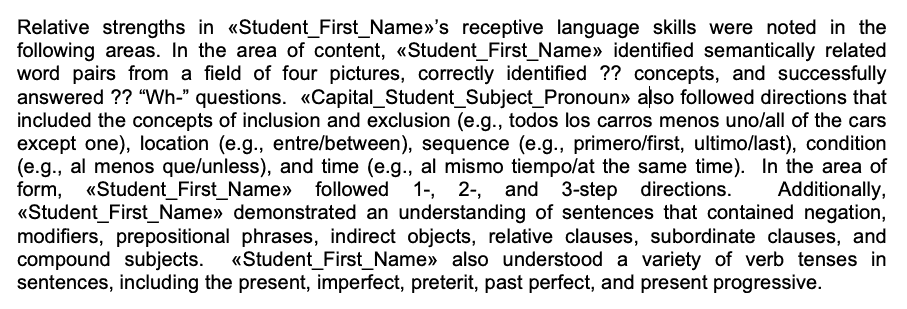Welcome back to our series on report writing. Today, we are going to talk about using and tweaking pre-written paragraphs in your report. Check out our first post on setting up a report template.
While we don’t have exactly the same paragraphs from one student to the next, the structure of our paragraphs is similar from one report to the next. For example, when I start my receptive language section, I always start with my diagnostic statement. My first sentence will look something like this:
“Student’s receptive language skills were WITHIN NORMAL LIMITS/BELOW AVERAGE.”
Next, I am going to give scores and discuss whether they are consistent with informal measures.
“Student’s standard score on the receptive language test (state it) was XX, placing him in the Xth percentile relative to students of his age and language background. Formal measures were consistent with informal measures and indicated that Student’s skills were WITHIN NORMAL LIMITS/BELOW AVERAGE.”
Next, I am going to state whether my findings were consistent with teacher and parent reports/concerns.
“Findings from formal and informal measures were consistent with parent and teacher concerns.”
So, if I have a pre-written paragraph for that, I can make a couple of selections and add any other necessary information.
Our paragraphs also vary based on the tests that we use. I included in my template different pre-written paragraphs for different tests. I found that I was searching for examples within my tests over and over again. I decided to include a bunch of examples from the test in my template. Since I usually test bilingual children, I was finding examples, typing them in Spanish, and then providing the English translation. Now those are in my report template and I delete them if I don’t need them. Deleting is always faster than creating so include as much as you can in your template.
Here is an example of a paragraph I use for the receptive language portion of the CELF-4-Spanish. It comes from my template so you’ll see the merge codes in it.

Don’t keep recreating work that you’ve already done. Keep your paragraphs and hone them over time. You’ll find that having pre-written paragraphs will speed up your writing process a lot.
Here’s a link to some verbiage we use in our reports. Another great resource for report writing is this blog post by the Dabbling Speechie.
Next up: Writing About Dynamic Assessment


